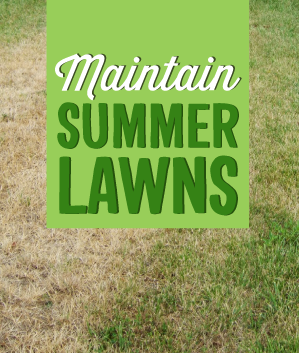Small, little improvements can go a long way! Here are some quick maintenance tips to improve the overall appeal and health of your lawn.
1) WATER DEEP & INFREQUENTLY IN THE EARLY MORNING
Make sure to water deeply enough to reach the roots. One inch of water per week is an ideal amount, but it is important you don’t soak your lawn. Try our one time, easy solution to confirm your lawn receives the proper amount of water.
You will need:
- Short, plastic containers (Tupperware, Rubbermaid, etc.)
- Stopwatch
- Hose / Sprinkler
- A “Can-Do” attitude
First, place the containers evenly throughout your lawn. Then turn on your sprinkler and start your stopwatch. While watering, observe the containers. Once they reach approximately one inch of water, turn off your sprinkler and record the time from your stopwatch. Make sure all containers are around one inch of water to ensure even distribution. Based on your findings, make proper adjustments to the placement of your sprinkler. This process will help you find the best location for your sprinkler as well as the ideal amount of time to water.
2) RAISE MOWING HEIGHT, MOW REGULARLY, & LEAVE THE CLIPPINGS
Keeping grass at the right length is the key when mowing lawns in the summer. Taller grass yields deeper roots that are more resistant to droughts and help prevent weed growth and germination. Follow the 1/3rd rule by only trimming 1/3rd of the grass blade with each mowing. It is recommended to keep your lawn longer during the hot, summer months to reduce heat and drought stress. It is best to mow your lawn during the evening when grass is dry. Make sure the mower blades are always kept sharp and clean and remember to switch up your mowing pattern regularly. It is best to allow grass clippings to fall back onto the lawn rather than being bagged. The clippings actually provide important nutrients to the grass and serve as a natural fertilizer. For tips on mowing, check out article: Mow Your Lawn.
3) FEED FOR A HEALTHY LAWN WHILE KILLING WEEDS
Feeding your lawn is crucial for overall health. A healthy lawn results in a lush and green appearance as well as strong root development. A strong root system helps fight heat, drought, traffic, disease, insects and other summer stresses. Using a Schultz Fertilizer with a Weed Preventer allows you to feed and kill broadleaf weeds in one easy application. Weeds can also be kept under control by keeping a dense, healthy lawn. Weeds should be removed in the summer before they germinate and begin growing. If weeds become a problem, use an effective post-emergent herbicide that targets weeds specifically without damaging your grass. Weed control is most effective when applied in temperatures below 85 degrees. If you are weeding by hand, make sure to remove the entire root system of the weed along with its top growth. For tips on using and choosing spreaders, check out our article: Spreaders 101.
4) AERATE YOUR LAWN
This is the process of puncturing numerous holes in the ground with either a rod or an automatic machine at a depth of 2 to 3 inches. Once you are finished, it is a great time to fertilize or overseed to improve the overall health and beauty of your lawn. Topdressing, after aerating with organic material, like compost or peat moss, improves soil structure for stronger turf in the long-run. Aerating is always a good idea when you have soil compaction as it is extremely effective in loosening the soil. Aeration creates a healthy root zone by increasing air space and allows water and fertilizer penetration to reach the roots. The optimal time for warm season grasses is in the spring/early summer, while cool season grasses flourish in the fall. Be sure to give your lawn time to repair before cool season dormancy occurs.
5) DETHATCH FOR HEALTHY LAWN
The removal of thatch helps maintain a healthy lawn. Decomposing grass, stems, dead roots and yard debris is considered thatch. It prevents water, sun, and fertilizer from reaching the roots. It is also a place for disease and insects to hide. Be sure to remove from your lawn anytime thatch is present. There are a few methods you can use to dethatch your lawn: 1) manual dethatching rake 2) mechanical dethatcher or vertical mower 3) power rake 4) dethatching attachments for your lawn mower blade. It is recommended that you power rake because it slices your grass vs tearing it, causing less damage to your lawn.








